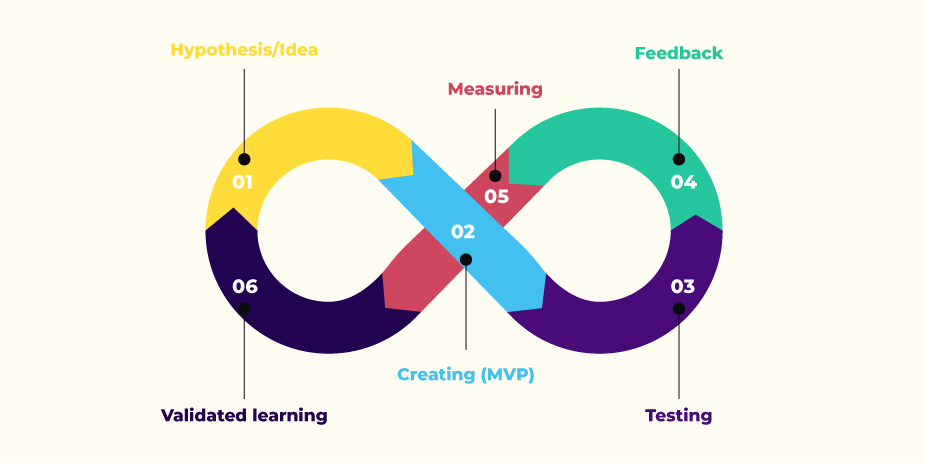Develop your product with validated learning

Learning, including learning from mistakes, is essential in the software development process. The validated learning process makes it possible to check whether the end user will be satisfied with the product. Find out what validated learning is and how to use it in product development.
What is validated learning?
The definition of validated learning derives from the Lean Startup methodology, which is an approach to efficient business development management. This methodology was created by Eric Ries and described in the book “The Lean Startup: How Today’s Entrepreneurs Use Continuous Innovation to Create Radically Successful Businesses.” Ries constructed the concept of the five principles of Lean Startup, in which validated learning is one of them.
Creating a new product requires setting goals and hypotheses; therefore, these conditions are described as highly uncertain. In order to reduce the feeling of uncertainty in making decisions about product development, Ries believes that the focus should be on effective and practical learning. The sooner a given hypothesis is disproved or confirmed, the faster we learn, and we can improve our product.
Validated learning is based on testing given solutions and checking which are good or not. To verify the assumptions, you need to get feedback from potential product users. After receiving this data, you can start the process of validating the assumptions and consider their possible modification.
MVP in the validated learning process
Minimum Viable Product (MVP) is a useable prototype that allows you to collect as much verified and measurable information as possible about the product and the needs of its potential users. Creating an MVP, launching it, and collecting data must be fast and cost-effective.
“Create – Measure – Learn” Loop
The basis of the Lean Startup methodology is the “Create – Measure- Learn” cycle. Using this loop, you can make business hypotheses and perform experiments (tests) that can be validated (concluding and verifying assumptions). The Minimum Viable Product (MVP) is tested during the cycle, and based on this quick experiment, we get users’ feedback.
The “Create-Measure-Learn” loop helps you to validate basic business hypotheses quickly. Without wasting time on producing a finished product, you create its prototype (MVP) and use specific indicators to analyze a given assumption.
Measurable results based on data
The key to validated learning is the measurability of the result. The process is based on measuring data, observing users’ involvement and their opinions about the product. The validated learning process means that we learn empirically, i.e., practically and based on evidence.
Thanks to validated learning, you can improve your product development with each iteration. A properly conducted process of validated learning is beneficial in creating a product that will meet users’ needs.
Prototyping is a great way to test a design concept in no time. Read our article on prototyping and find out why you should start working on your idea with a product prototype.
Validated learning process
- 1. Defining hypothesis or idea
- 2. Building an MVP
- 3. Testing / Experimenting
- 4. Measuring by receiving honest feedback
- 5. Validated learning from conclusions
- 6. Generating new ideas

The loop above allows you to formulate business hypotheses, test and analyze them. Thanks to iteration, it is possible to confirm or deny given assumptions, which offers the basis for drawing conclusions and verifying hypotheses.
The sooner a hypothesis is confirmed or rejected during a given iteration, the faster product development will take the right direction. The empirical data generated during the loop will result in conscious decisions, adjusting the product to the market and users’ expectations.
Why follow a validated learning approach?
The implementation of the process of validated learning in work on the product has many advantages:
- helps shorten the product development process,
- eliminates the creation of unnecessary functions,
- thanks to empirical data based on user feedback, the product becomes customer-oriented,
- testing is a source of valuable knowledge about consumers and their needs,
- shorter product development time translates into financial savings,
- flexibility and agility in working on the product, purpose, and mission are promoted.
Validated learning and customer-centricity
Validated learning enables us to truly learn about the market and users’ needs without wasting time on wrong assumptions. Actual interactions with real customers allow for a thorough insight into users’ real problems and needs. The product becomes customer-oriented and can succeed once it is launched on the market.
Validated learning allows you to answer questions such as:
- Do our clients know they have a problem we want to solve?
- Would our customers decide to buy our product if it solves their problem?
- Would our customers buy this product from us?
- Can we build a product that will actually solve their problem?
Validated learning and Scrum
The Scrum methodology is based on empiricism. In empiricism, knowledge comes from experience, and decisions can be made only based on what we know. That is why validated learning is closely related to Scrum.
One of the common characteristics is that the process is iterative, as the loop, so that the team learns more and more with each iteration. Flexibility and focus on the user manifest themselves through prototyping or A/B tests.
At appjet.io, we use both the Scrum methodology and the process of validated learning. We build an MVP based on data and measure the effects of our work. We want the product we are working on to satisfy both the end user and our client.
Our appjet.io team will help you build a validated learning MVP. Contact us and let us create a customer-centric product.




